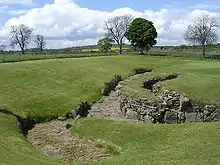Carlungie and Ardestie earthhouses
Carlungie and Ardestie Earthhouses can be found in farmland north of Monifieth and Carnoustie. They date to the late Iron Age, from the 1st to 2nd centuries AD. They are examples of souterrains, probably used to store food.
Ardestie Earthhouse


Ardestie earthhouse was discovered in the 1940s to the north of Mains of Ardestie farm.[1] It was excavated in 1949-1950 by F.T. Wainwright, who first suggested that the function of the souterrain was as an underground cow byre, although grain storage and ritual use have also been suggested.[2] Incorporated into the structure are recycled stones with neolithic/Bronze Age cup and ring marks
Carlungie Earthhouse

Carlungie earthhouse was excavated in 1950–1951, also by Wainwright. It is of similar date and a similar interpretation of its utilisation was made.[3]
References
- Historic Environment Scotland. "Ardestie, souterrain 400m NW of Mains of Ardestie (SM90021)". Retrieved 26 February 2019.
- Watkins, T (1978). "Excavation of a settlement and souterrain at Newmill, near Bankfoot, Perthshire". Proceedings of the Society of Antiquaries of Scotland. 110: 165–208.
- Historic Environment Scotland. "Carlungie, souterrain 160m WNW of (SM90059)". Retrieved 26 February 2019.